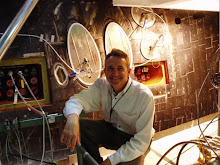 Cutting the airframe and filling spirals proved to be more difficult than I expected. I had cut 6" tubing on my table saw in the past but was never happy with the results. Turning the tube seemed like a reasonable option - I thought I could make clean cuts that way and quickly dispense with the spirals. The 10" µMLAS airframe was too big for my lathe, so I built a mandrel to turn it vertically in my drill press using the lathe's drive spur and a dead center sold by Penn State Industries mounted to the drill press table. At right you can see the entire assembly on the drill press as it appeared just before I made the cuts. This worked, but constructing, balancing, and trimming the mandrel turned out to be a time-consuming chore of its own and the final tubing cuts were not as clean as I'd hoped. I did get the spirals filled and sanded, but if I had the whole thing to do again I'd probably do the cuts by the old "tape and razor saw" method and fill the spirals by hand. Live and learn.
Cutting the airframe and filling spirals proved to be more difficult than I expected. I had cut 6" tubing on my table saw in the past but was never happy with the results. Turning the tube seemed like a reasonable option - I thought I could make clean cuts that way and quickly dispense with the spirals. The 10" µMLAS airframe was too big for my lathe, so I built a mandrel to turn it vertically in my drill press using the lathe's drive spur and a dead center sold by Penn State Industries mounted to the drill press table. At right you can see the entire assembly on the drill press as it appeared just before I made the cuts. This worked, but constructing, balancing, and trimming the mandrel turned out to be a time-consuming chore of its own and the final tubing cuts were not as clean as I'd hoped. I did get the spirals filled and sanded, but if I had the whole thing to do again I'd probably do the cuts by the old "tape and razor saw" method and fill the spirals by hand. Live and learn.The real MLAS airframe proved to be a bigger challenge than expected too. The test article was not significantly weight-constrained, so we opted to build the fairing and skirts from a simple fiberglass-over-foam composite manufactured by Northrop-Grumman at their Gulport, Mississippi, shipyard. Balsa was used for the core instead of foam in locations where loading dictated (seemed strange to build real flight hardware out of traditional modeling materials - foam and balsa - but there we were). The fairing and skirts were manufactured in sections, shipped cross-country by truck, and assembled at Wallops. Our excitement on taking delivery of the first sections was dampened when we took some core samples to test the strength of the composite layup: the first cuts reeked of uncured epoxy. As it turned out, the adhesive used to layup some of the sections reacted adversely with a pre-applied adhesive in the cloth and the composite didn't cure properly. The whole episode cost us several months while Northrop manufactured new parts, and provided some lessons in "unintended consequences" ... the professional version of live and learn.

2 comments:
Is it M L A S or "EmLass"?
The latter: "em-lass"
Post a Comment